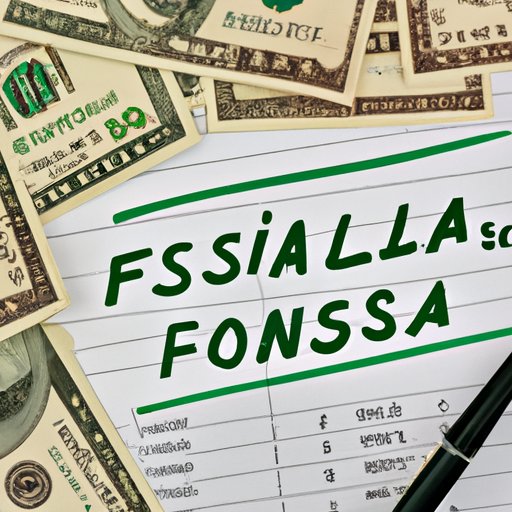
Introduction
First things first, what is FSA money? FSAs are a benefit offered by some employers that allow employees to set aside pre-tax dollars for eligible healthcare expenses. This means that you can save money on healthcare expenses by using pre-tax dollars, as opposed to after-tax dollars. The maximum amount that you can contribute to an FSA varies by employer and by plan.
Once you have contributed money to your FSA, you can use those funds to pay for eligible healthcare expenses throughout the year. Because you are using pre-tax dollars, you end up saving money on these expenses.
It is crucial to know how to use FSA money, as it can help you save money on healthcare expenses and maximize your benefits. Let’s dive into the specifics.
Eligible Expenses
Not all healthcare expenses are eligible for FSA coverage. Eligible expenses are defined by the IRS and include a variety of healthcare-related costs. Some of the most common eligible expenses include:
- Medical, dental, and vision copayments and deductibles
- Prescription medications
- Medical supplies (such as bandages or contact lenses)
- Diagnostic tests and laboratory fees
- Physical therapy and mental health services
- Chiropractic and acupuncture services
It is important to note that over-the-counter medications are only eligible for FSA coverage with a prescription from a doctor. Additionally, some healthcare expenses are not eligible for FSA reimbursement, such as cosmetic procedures and health club memberships.
Submitting Reimbursements
Now that you know which expenses are eligible, how do you actually get reimbursed for them?
The process for submitting FSA reimbursements varies by employer and plan, but generally, you will need to submit a claim form with receipts or other documentation of the expense. Some employers have online portals for submitting claims, while others require you to submit a paper claim form.
When submitting a claim form, be sure to include all required documentation. You may need to provide itemized receipts or other proof of payment. It is important to keep these receipts, as they can be audited by the IRS to ensure that the expenses were eligible.
Some FSA plans also have timelines for submitting claims and receiving reimbursement. For example, you may need to submit a claim within 90 days of the expense and receive reimbursement within 30 days of the claim submission.
Planning Ahead
One of the best ways to maximize your FSA dollars is to plan ahead. By estimating your healthcare expenses for the year, you can ensure that you are contributing the appropriate amount of money to your FSA.
Some strategies for planning ahead include:
- Estimating your out-of-pocket expenses for the year
- Anticipating any upcoming healthcare needs (such as a planned surgery or dental work)
- Checking with your healthcare provider to confirm the cost of a procedure or service
By planning ahead, you can also make the most of your FSA dollars. For example, you may be able to use any remaining FSA funds to purchase eligible expenses at the end of the year, such as prescription glasses or contact lenses.
Another technique for maximizing your FSA dollars is to create a budget for eligible expenses. By budgeting for these expenses, you can ensure that you are not overspending on healthcare costs.
Flexibility
One of the benefits of FSA money is that it can be flexible. For example, some FSA plans allow for rollover funds, meaning that you can carry over unused FSA funds from one year to the next. This can be beneficial if you did not use all of your FSA funds in the previous year.
Another way to maximize your unused FSA funds is to use them for eligible expenses throughout the year. For example, if you have a few hundred dollars left in your FSA at the end of the year, you can use those funds to purchase eligible expenses that you will need in the upcoming year.
It is important to note that FSA funds are typically “use it or lose it,” meaning that any remaining funds at the end of the year will be forfeited. Be sure to check with your employer to see if your FSA plan allows for rollover funds or if there is a grace period for using FSA dollars beyond the end of the plan year.
Common Pitfalls
Using FSA money can be tricky, and there are some common pitfalls to avoid. One important thing to keep in mind is to track your FSA expenses carefully. By keeping track of your expenses, you can ensure that you are using FSA funds for eligible expenses and avoid any potential consequences for improper usage.
Another common mistake is not planning ahead for eligible expenses. By estimating your healthcare expenses for the year and creating a budget, you can ensure that you are contributing the appropriate amount of money to your FSA.
Finally, be sure to check with your employer about any specific rules or regulations regarding FSA usage. Improper usage can result in consequences, such as losing FSA funds or even legal action.
Conclusion
Using FSA money can be a great way to save money on healthcare expenses. By understanding which expenses are eligible, how to submit reimbursements, and how to plan ahead for healthcare expenses, you can maximize your FSA dollars and save money in the long run.
Be sure to keep track of your FSA expenses, plan ahead for eligible expenses, and check with your employer for any specific rules or regulations regarding FSA usage. With these tips in mind, you can make the most of your FSA money and enjoy the benefits of pre-tax savings on healthcare expenses.





